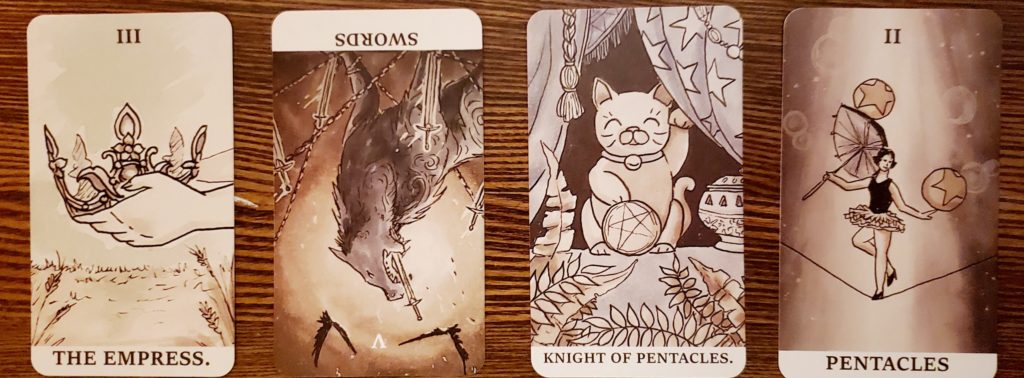Your cart is currently empty!
by
Tags:
How Does the Tarot Actually Work?

Even after 20+ years, I still wonder about this sometimes. Although I have a ‘technical’ answer, I’m still amazed at how spot-on the cards are. What’s the deal with that?
There are actually a number of things going on that make tarot such an effective tool for divination and introspection.
Overview of Tarot Structure
The structure of the tarot has remained largely unchanged over the last 500 + years. The tarot is a specific system consisting of (usually) 78 cards divided into two sections: 22 cards in the Major Arcana, and 56 cards in the Minor Arcana. The 22 cards of the Major Arcana, numbered 0 – 21, detail archetypes of human spiritual development from birth to enlightenment. The 56 cards of the Minor Arcana are divided up into 4 suits each numbered 1 (ace) through 10, with 4 court cards. The suits’ names/symbols might vary somewhat, but they almost always correspond to the 4 elements of Earth, Air, Fire, and Water. These images or symbols are depictions or interpretations of everyday events in human lives.

How It ‘Works’
The symbols, colors, images, and patterns on the cards work on the unconscious mind. There is a part of us that innately understands the universal language of symbol and color. But we live in the age of science and reason, with a focus on our conscious mind (the ego, psychologically speaking), leading to a dismissive attitude toward the intuitive or psychic.
So ‘reading’ the symbols and images on the cards takes some interpretation for many of us, although it is only the conscious mind that needs this interpretation – as I said above the unconscious already understands what it’s seeing. And so really, it’s not as much an interpretation as it is learning how to tap into the unconscious that has this knowledge. I’m going to say that again because it is fundamental to tarot reading: learning to ‘read’ tarot cards is just as much about learning how to tap into our unconscious, as it is learning the meaning of individual cards. It is our unconscious mind that communicates with our higher/inner self (or energy or spirit), and it is the higher self that can guide us to live the life we truly desire. That is the essence of reading cards intuitively: learning how to listen to the quiet voice of our higher selves – our intuition.
Unfortunately some of us – myself, for one – need something more concrete to work with while we slowly learn to work with our intuition. And that’s the beautiful thing about tarot: it works on an intellectual level as well. Which is one of the reasons it’s still so popular – there is both a conscious and unconscious pull to the cards. It’s why so many of us find them fascinating on multiple levels.
Bringing these two methods of reading/interpreting the tarot together gives us the most holistic understanding of how the cards speak as individuals and as a combined whole to create the larger picture of a reading.
So what’s the tarot reader’s role?
My job as a reader is two-fold: the first is to help you listen to /tune in to your own unconscious and higher self through card imagery (intuitive reading). The second is to interpret readings by looking at esoteric connections and associations in and between the cards, listing to my own intuitive guidance and interpretations, and empathically focusing on my client’s perspective.
Why not just read the cards for clients and leave it at that? Because helping my clients make the connections and associations for themselves is a more effective means of self-transformation. If I’m just feeding you information, it may be helpful on an intellectual level but will be less impactful than if you’re having insights and emotional reactions along the way.
What about reading the future?
The amount of divinatory (‘fortune telling’) focus in reading varies from reader to reader. Clairvoyant readers and some intuitive readers specialize in predictive reading and that’s specifically what you’ll get. Other intuitive readers (myself included) prefer to focus on introspective reading, which gives the client options for taking control of events, instead of just being witness to them. Introspective readings still have a divinatory nature, but that doesn’t become the focus of the reading. How to reach that foretold possible future becomes the focus.
Leave a Reply